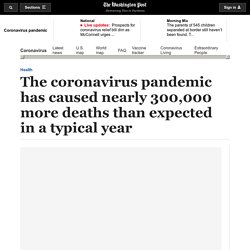

Great FT article with numbers: Covid-19: The global crisis — in data. Daily deaths (7-day rolling average) Jan 10 Start of ‘Chunyun’ Jan 23 Wuhan lockdown begins April 8 Wuhan lockdown ends The emergence of a new Sars-like coronavirus could not have come at a worse time for China.

The country was already 10 days into Chunyun — the Lunar New Year travel season that is also the largest annual human migration on the planet — when government officials finally confirmed human-to-human transmission of the as-yet-unnamed virus on January 20. The city at the centre of the outbreak, Wuhan in Hubei province, went into lockdown three days later. Exodus before lockdown Flights out of Wuhan by destination, Jan 18-24 Given the scale of human movement, further spread of the virus across China seemed inevitable. Despite pre-lockdown travel from Hubei, China managed to contain its Covid-19 outbreak Cumulative confirmed coronavirus cases, by province, as at October 13 2020 Mar 13 WHO declares Europe epicentre of pandemic Mar 23 UK enters lockdown.
Pan American Health Organization. Skip to main content Show filters.

Positive Rate - Statistics and Research. WHO Coronavirus Disease (COVID-19) Dashboard. How Does Testing in the U.S. Compare to Other Countries? - Johns Hopkins Coronavirus Resource Center. Home - Johns Hopkins Coronavirus Resource Center. Covid-19 data - Tracking covid-19 excess deaths across countries. AS COVID-19 has spread around the world, people have become grimly familiar with the death tolls that their governments publish each day.
Unfortunately, the total number of fatalities caused by the pandemic may be even higher, for several reasons. First, the official statistics in many countries exclude victims who did not test positive for coronavirus before dying—which can be a substantial majority in places with little capacity for testing. Second, hospitals and civil registries may not process death certificates for several days, or even weeks, which creates lags in the data. And third, the pandemic has made it harder for doctors to treat other conditions and discouraged people from going to hospital, which may have indirectly caused an increase in fatalities from diseases other than covid-19.
Many Western countries, and a handful of nations and regions elsewhere, regularly publish data on deaths from all causes. How many people has the coronavirus killed? At the beginning of March, Andrew Noymer felt a familiar twinge of doubt.

He was watching countries across Europe and North America begin to record their first deaths from COVID-19, and he knew there could be problems with the data. Even in a normal winter, some deaths caused by influenza get misclassified as pneumonia. If that can happen with a well-known disease, there were bound to be deaths from COVID-19 going unreported, thought Noymer, a demographer at the University of California, Irvine. “I just remember thinking, ‘this is going to be really difficult to explain to people’,” he recalls. And in March and April, when national statistics offices began to release tallies of the number of deaths, it confirmed his suspicions: the pandemic was killing a lot more people than the COVID-19 figures alone would suggest. But this high-level metric has several flaws. Several media outlets are already crunching the data and drawing such conclusions. Blunt tool Digging into data Taking stock.
The coronavirus pandemic has caused nearly 300,000 more deaths than expected in a typical year. It is not clear whether that spike is caused by the shift in covid-19 deaths toward younger people between May and August or deaths from other causes, the CDC said.

The report comes with just two weeks left in a presidential campaign whose central issue is President Trump’s handling of the pandemic. Trump has sought at every turn, including in remarks Monday, to minimize the virus’s impact, despite a covid-19 death toll that is likely to be the third-leading cause of mortality in the United States this year, behind heart disease and cancer. That stance has proved to be the president’s enduring weakness as the election looms Nov. 3. His Democratic opponent, former vice president Joe Biden, has made his plans to tackle the pandemic the major focus of his bid to capture the White House. The United States is in the midst of another sharp increase in coronavirus infections, this one centered in the upper Midwest and Plains states. The new CDC data covers Feb. 1 to Oct. 3. Lauren M.